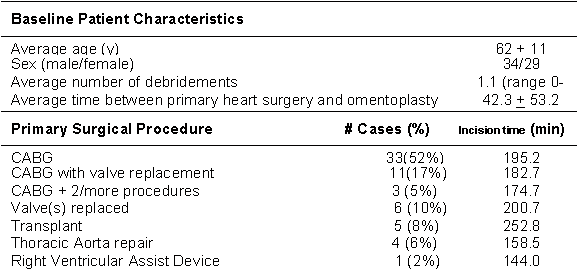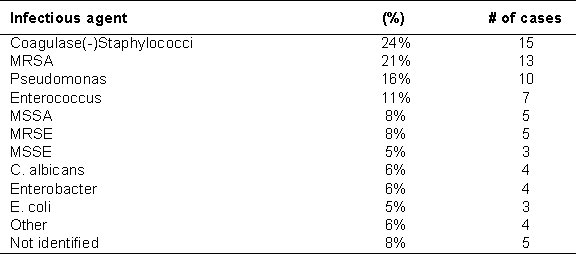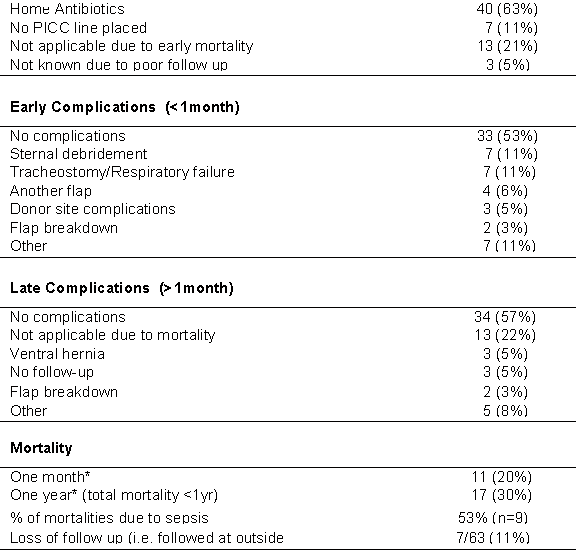Sunday, October 10, 2004
5711
Omental Flap Coverage in Post Cardiothoracic Surgery Mediastinitis
Median sternotomy infection and dehiscence occurs in 0.3-5.0% of all cardiothoracic surgeries and is associated with high morbidity and mortality in the range of 10-47%. Furthermore, the cost of hospitalization for mediastinitis increases three fold above the usual cost for coronary artery bypass graft or approximately $60,000.00. This report reviews the patient demographics of those who develop mediastinitis and to observe the outcomes after omentoplasty including: flap survival, early and late general complications, length of hospital stay, and mortality. The patientsí surgery admission dates ranged from July 1993 to April 2003. 63 patients were found to have omentoplasty for mediastinitis. The patient hospital records were retrospectively reviewed for the following data: demgraphics, length of time between initial sternotomy and omental flap procedure, microbiology of infection, and number of debridements/procedures prior to omentoplasty. Outcome parameters that were reviewed include: average hospital stay after omental flap procedure, flap success, percentage of patients who were placed on home antibiotic therapy, early and late complications, and mortality rates. Of the 63 patients who underwent omentoplasty, the average hospital stay post-surgery was 18.1 days + 15.7. Thereafter, 63% of the patients had peripherally inserted central catheter (PICC) lines placed for a course of six week antibiotic therapy. 76% of the flaps went on to be successful, with only 2 flaps (3%) breaking down. It should be taken into consideration that 11 cases were not included in the success rate due to the patientís early mortality. 53% of the cases were complication free within the first month. Furthermore, 57% of cases were not inflicted by late complications. However, if the 13 patients who died after the first month due to complications outside of their omental flap are removed, then 73% of the cases were problem free. Observed mortality rates were 20% in the first month and 30% up to the first year. DISCUSSION Our flap success rate of 96% (n=48/50, due to 13 deaths unrelated to the flap surgery) greatly correlates with previously published rates that fall within 89-98%. 47% of the cases encountered early complications. Problems observed in the first month after surgery included, further sternal debridement, tracheostomy due to respiratory failure, flap revision, donor site complications and flap breakdown. Fewer late complications were observed and included ventral hernias, flap break down, and further flap procedure (i.e. pectoralis coverage). The mortality rates of 20% prior to one month and 30% prior to one year closely follow that found in the literature which showed a range of 20-46.6%. However, these are also greater than a few smaller studies that published rates of approximately 5%. Omental flap coverage was the recommended treatment for significant anterior and pan mediastinitis, however, in most cases that this technique was used, included individuals with very severe infections and with multiple comorbidities. Furthermore, 9 of 17 deaths within the first year after omental flap surgery involved septic infections, four of which inflicted heart transplant patients. Those cases of deep sternal wound infection that were less severe or that occurred in patients with less comorbidity have great success with omental flaps as primary treatment.
View Synopsis (.doc format, 54.0 kb)




